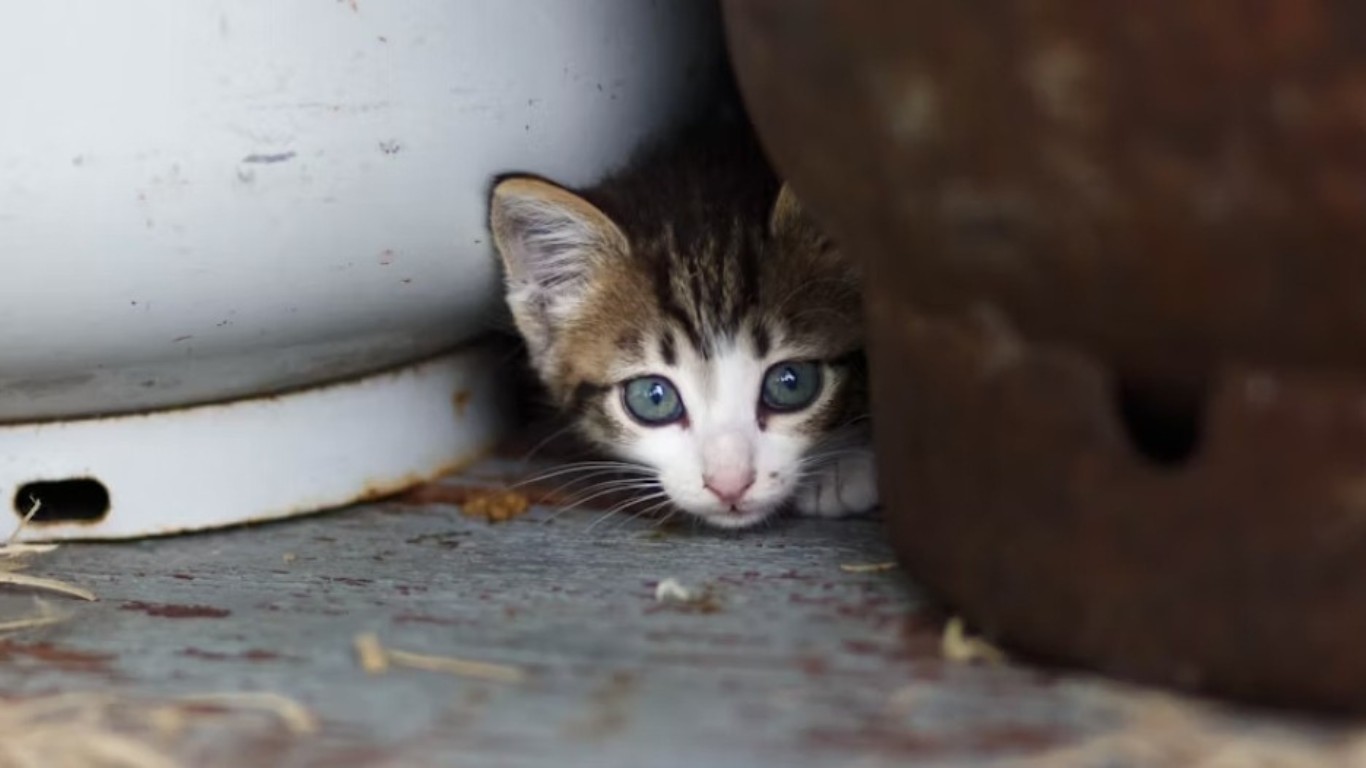As a long-time cat owner and lover, I will be sharing some of the most common reasons your new cat is hiding and not eating based on my experience with cats and the information I gathered from my friends who brought in new cats.
In this post, I’ll be discussing some reasons your new cat is hiding and not eating and what you should do to address this behavior.
There are many reasons your new cat might be hiding and not eating. Keep reading to find out more…
Why Is My New Cat Hiding and Not Eating
Your new cat is likely hiding and not eating due to stress and anxiety from the change in environment, being sick, injured, or scared, which is common for newly adopted pets.
It may also take time for a new cat to adjust to new surroundings, smells, and sounds, causing it to seek refuge in a safe space.
Ensuring a quiet, secure area and gradually introducing it to its new home can help ease this transition.
Reasons Your New Cat Is Hiding and Not Eating

In my opinion, here are some of the most common reasons your new cat is hiding and not eating and what to do:
1. Stress and anxiety from changing environment
Based on the experience I had with my cat Max, I can tell you that most cats sometimes hide and refuse to eat until they feel more comfortable in their new surroundings since moving to a new place can be stressful for them.
Hiding in tight places, avoiding social situations, overgrooming, or raising vocalization are some common indicators of stress and anxiety in new cats.
To address this, I recommend you make sure your new cat has a secure and cozy environment immediately after you bring them home.
You should also try and provide a peaceful space with a comfortable bed, food, drink, and a litter box for them.
You should try to create a relaxing atmosphere and employ calming sprays or pheromone diffusers.
Make sure you don’t force engagement; instead, give your cat plenty of time to become used to their new surroundings and explore them at their own leisure.
You should also try and gradually introduce them to the rest of the house and provide plenty of opportunities for play and mental stimulation.
2. Past negative experiences or trauma
Some cats may have had negative experiences or trauma in their past, which can contribute to their hiding and lack of appetite.
These experiences could include abuse, neglect, or being stray for a prolonged period.
To address this, it’s important to be patient and understanding with your new cat, you should give your new cat space and allow them to approach you on their terms.
I advise you should create positive associations by offering treats, gentle petting, and comforting words when they do venture out.
You should also consider consulting with a professional animal behaviorist who can provide specialized guidance and support.
3. Feel threatened or intimidated by other pets
If you have other pets in your household before bringing in a new cat, your new cat may feel threatened or intimidated.
This can lead to hiding and a loss of appetite, and some signs of this behavior include tense body language, hissing, growling, or swatting.
To address this behavior, you should gradually introduce your new cat to your other pets.
You can start with scent swapping by exchanging bedding or using a pheromone spray to familiarize them with each other’s scents.
I advise you should use baby gates or crates to create a safe visual barrier, allowing them to observe and become accustomed to each other without direct contact.
You should also try to provide separate feeding areas and resources to avoid competition.
Remember to always supervise all interactions and provide positive reinforcement for calm and non-aggressive behavior.
4. Your new cat wasn’t properly socialized as a kitten

If your new cat wasn’t properly socialized as a kitten, they may struggle with fear and lack of trust, leading to hiding and avoiding food when they arrive new in your house.
This could be due to being separated from their mother and littermates too early or limited exposure to humans and other animals during their critical socialization period.
To address this behavior, you should start by building trust through gentle and consistent interactions.
You should also offer treats, playtime, and praise when your cat shows positive responses.
Try to gradually introduce new experiences, people, and animals in a controlled and positive manner.
Patience and gradual exposure will help your new cat develop confidence and overcome their socialization challenges.
5. Too much human interaction
Some cats may become overwhelmed by excessive human interaction, leading them to hide and lose their appetite.
Signs of this behavior can include avoiding eye contact, flattening their ears, or retreating to secluded areas.
To address this behavior, you should provide your cat with a quiet and peaceful space where they can retreat when they need alone time.
You should always allow them to approach you for affection and play at their own pace.
Try to respect their boundaries and give them space when they show signs of discomfort.
You should also gradually increase interaction as your cat becomes more comfortable, ensuring you provide a balance between stimulation and solitude.
6. Fear of the new environment
When introduced to a new environment, some cats may feel fearful and overwhelmed, causing them to hide and refuse to eat.
Signs of fear in new cats can include crouching, trembling, or attempting to escape.
To address this behavior in new cats, you should create a safe and secure space for your cat, such as a dedicated room or area, equipped with their essentials like a litter box, food, and water.
You should also gradually introduce them to the rest of the house, starting with small supervised visits.
You can use positive reinforcement techniques, such as treats and praise, to reward calm behavior.
Furthermore, you should allow your cat to explore at their own pace, providing hiding spots and vertical spaces for them to feel secure.
Consistency and patience are key in helping them overcome their fears.
Related: How to know your new cat is adjusting.
7. Fear of loud noises or sudden sounds in the new home
Loud noises or sudden sounds can be distressing for new cats, causing them to hide and lose their appetite.
Signs of this behavior in new cats can include flattened ears, dilated pupils, or attempts to find a quiet hiding spot.
To address this behavior in your new cat, you should try to create a peaceful environment for your new cat.
You can use white noise machines or calming music to drown out loud noises.
I advise you to provide lots of hiding spots and safe spaces where your cat can retreat during potentially stressful situations.
You should also gradually expose your new cat to these sounds by playing recorded noises at a low volume and gradually increasing them over time.
You should try and associate positive experiences, such as treats or playtime, with these sounds to help your cat build positive associations.
8. Overwhelming activity levels in the new environment

An environment with high activity levels can be overwhelming for a new cat, causing them to retreat and lose their appetite.
Signs of this behavior in new cats can include hiding in inaccessible areas, excessive grooming, or avoiding interaction.
To address this behavior in your new cat, you should try to create a calm and quiet space for your cat to retreat to when they feel overwhelmed.
You should also gradually introduce them to different areas of the house, allowing them to explore at their own pace.
Try to set up vertical spaces, such as cat trees or shelves, where they can observe their surroundings from a safe distance.
Furthermore, you should establish a routine that includes scheduled playtime and interactive sessions to provide mental and physical stimulation while keeping activity levels manageable.
9. Adjustment period and change in routine
During the adjustment period of your new cat, they may hide and show a decreased appetite this is a normal behavior in cats.
Signs of this behavior in new cats can include excessive sleeping, reluctance to engage in play, or avoiding social interaction.
To address this behavior in your new cat, you should maintain a consistent routine for feeding, playtime, and interaction.
You should try to provide a quiet and comfortable space where your new cat can feel secure during the adjustment period.
You should also try to gradually introduce changes to their routine, such as new feeding times or rearranging furniture, to help them acclimate.
You can also offer enticing and high-quality food to stimulate their appetite. Keep in mind that patience and understanding are key during this transitional phase.
Read more about cat behavior problems.
How to help your new cat adjust

Welcoming a new cat into your home can be both exciting and challenging.
To help your new cat adjust, you should start by setting up a quiet, cozy space for your feline friend, complete with a comfy bed, litter box, and freshwater to help them feel safe and secure.
You should also try to gradually introduce your new cat to the rest of your home, allowing them to explore at their own pace to prevent overwhelming them.
Try to spend quality time interacting with your new cat through gentle petting and play, building trust and a sense of companionship.
Finally, you should maintain a consistent routine for feeding and playtime to provide a reassuring sense of stability.
Read more about your cat not getting along with other cats.
Final Thoughts
In summary, if your new cat is hiding and not eating, it could be due to stress and anxiety from the unfamiliar environment.
Providing a quiet and safe space, along with patience and gentle encouragement, can help them feel more comfortable and gradually adjust.
If the behavior persists, consulting with a veterinarian can rule out any underlying health issues.









